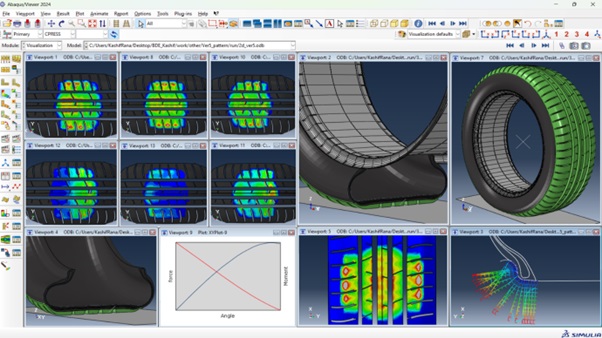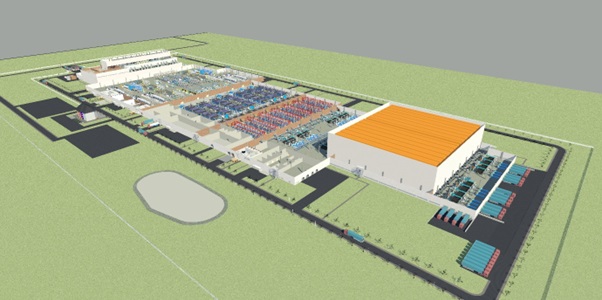Real-World Testing: A Timeless Necessity For The Tyre Industry
- By Sharad Matade & Gaurav Nandi
- December 26, 2024

Making a tyre is an extensive process that includes everything from formulation to testing. With the advancement in software-defined technology, tyre testing is increasing within a simulated environment. However, as real as the rubber wheel is, its testing in real-world environment stands as imminent in future course despite the current trend of simulation.
Alluding to this, Black Donuts Head of Tyre and Material Development Ilkka Lehtoranta told Tyre Trends, “Alongside the advanced laboratory equipment and various simulation methods, real-world tyre testing remains essential now and in the future. Physical testing in diverse conditions is critical for final evaluation and validation. Real-world tyre testing will continue to play a significant role moving forward. At Black Donuts, we offer comprehensive tyre testing services through our subsidiary, BD Testing. This company specialises in outdoor testing to ensure that products perform reliably in all environments.”
Commenting on the role of simulation in tyre development, he said, “Simulation plays a critical role in tyre development, offering a proven and essential part of the design process. One key type of simulation is finite element analysis (FEA), a mathematical method used to model and simulate physical phenomena. FEA is widely employed across industrial sectors including tyre manufacturing to predict and validate design performance before creating physical prototypes.”

“For tyre development, simulation tools provide significant advantages. By conducting design verification and validation virtually, companies can reduce the need to produce experimental tyre, which saves raw materials and minimises waste. This approach not only supports environmental goals but also accelerates the development timeline, allowing for faster iterations and refinements. Black Donuts integrates various simulation methods into its development process, heavily relying on the results to optimise designs,” he added.
Testing facilities
The Finnish company offers comprehensive tyre testing services with a primary focus on outdoor testing rather than indoor facilities. While indoor testing facilities are widely available globally, including in Europe, Asia, India and North America, Black Donuts has chosen to concentrate on outdoor testing. The company leverages the expertise of skilled test engineers and drivers, who understand the nuances of environmental and external factors, to deliver dependable testing outcomes.
“We operate a proving ground in northern Sweden, where winter tyres are tested under snowy and icy conditions. Additionally, we have a testing centre in Finland’s Tampere region, which serves as a hub for evaluating tyre properties across a range of conditions. The facilities enable grip testing on ice, snow, wet and dry surfaces; noise testing for internal and external evaluations; handling and comfort assessments; aquaplaning analysis and tailored tests developed to meet specific customer needs,” informed Lehtoranta.
He mentioned that test drivers are central to Black Donuts' outdoor testing process as their expertise in assessing tyre behaviour is critical for validating designs and providing feedback to engineers. This collaboration ensures the test results are seamlessly integrated into the design and development process, allowing engineers to refine tyre properties based on real-world performance insights.

Winter testing is conducted during the colder months to utilise natural snow and ice conditions. While the company does not have an indoor snow-testing facility, it makes use of local resources such as ice halls for ice-related evaluations. For summer tyres, the focus shifts to testing grip, handling and noise levels under both dry and wet conditions.
In addition to testing during tyre development, Black Donuts supports homologation and certification processes. Through its subsidiary, BD Testing, the company provides accredited testing services and official test reports required for certifications by authorities. This includes European homologation tests for snow and ice performance, as well as specialised assessments such as road wear impact evaluations for studded tyres in Scandinavian markets.
The company also conducts internal testing to collect data, monitor market trends and benchmark tyre performance. “This continuous research helps us to identify industry standards and emerging trends, ensuring that our tyre development projects remain innovative and competitive,” averred Lehtoranta.
Industry peek
Black Donuts provides end-to-end solutions for the global tyre industry, catering to both manufacturing and tyre research and development needs. Its services cover tyre design and production, materials research and development, making the company a comprehensive partner for tyre manufacturers globally. Whether supporting the establishment of new tyre plants, upgrading existing facilities or offering specific technical expertise, it has a broad portfolio of engineering and technological solutions.
In production, Black Donuts assists manufacturers with everything from setting up greenfield projects to improving brownfield facilities. For existing manufacturing lines, the company conducts thorough audits to identify bottlenecks, inefficiencies and quality issues. The focus often includes increasing automation, enhancing productivity, reducing manufacturing costs, improving quality, minimising scrap and waste and even reducing tyre weight. These solutions are tailored to meet the specific demands of the client.
For greenfield projects, it offers turnkey solutions. These include site selection support, plant layout design, architectural planning, defining machinery specifications, automation strategies and utility calculations. During the execution phase, an on-site engineering team supervises construction, machinery installation, commissioning and the ramp-up of production processes. The company also trains operators, troubleshoots quality issues and supports clients in improving efficiency. The level of post-production support is flexible with options for ongoing assistance tailored to the client's needs.

Alluding to how the design and production process differ across regions, the executive said, “The design and production processes themselves are generally consistent across regions. However, automation levels may vary based on factors like labour costs and plant location. European facilities, for instance, often require higher automation levels due to higher manpower costs, though automation is increasingly being adopted in Asia as well. This trend has significantly reduced manpower requirements in tyre manufacturing globally, driven by advancements in automation technologies.”
Research and development
In tyre development, significant trends include the growing demand for sustainability, increased automation in production processes and evolving design needs tailored to regional and market-specific conditions. Tyre materials development is a subset of tyre development but is critical due to its role in addressing environmental and performance challenges. Black Donuts works on both these aspects, helping clients innovate while navigating changing demands in the tyre industry.
The push for sustainability is the most pressing challenge in tyre material development. There is an increasing emphasis on replacing fossil-based materials with sustainable alternatives like bio-based and recycled raw materials. Black Donuts plays a pivotal role in identifying and testing new materials available in the market, integrating them into tyre compounds and ensuring its compatibility with production processes.
In addition to working with existing materials, Black Donuts has initiated its own research and development efforts to explore innovative, out-of-the-box sustainable solutions. These include new bio-based raw materials currently under internal development, which are expected to be launched soon.
On the tyre development front, it offers comprehensive services for creating new tyre lines across segments like passenger car radial (PCR), truck and bus radial (TBR) and off-the-road (OTR) tyres. The designs cater to various markets including Europe, US, Asia and Africa, ensuring optimal performance under different environmental and regulatory conditions.
Customisation for specific client needs, whether summer or winter tyres, and adapting designs to suit regional preferences are also part of the company's everyday operations.
Competitive edge
The rapid evolution of technology, automation and sustainability trends demands agility and adaptability. Black Donuts maintains an active presence in the market, staying updated on global developments by leveraging its extensive partner network, including machinery and raw material suppliers, to gather insights and anticipate emerging trends.
 Alluding how the company selects partners, the executive revealed, “The partner selection process is fundamental to delivering high-quality, innovative solutions. Many members of our team have decades of experience and longstanding relationships with suppliers, which provide a solid foundation for selecting trusted partners. Besides, there are several factors that are taken into account to source new partners.”
Alluding how the company selects partners, the executive revealed, “The partner selection process is fundamental to delivering high-quality, innovative solutions. Many members of our team have decades of experience and longstanding relationships with suppliers, which provide a solid foundation for selecting trusted partners. Besides, there are several factors that are taken into account to source new partners.”
One of the most crucial factors in selecting partners is the technological capability. Black Donuts prioritises partners that offer cutting-edge technologies, which can add value to both the company and its customers. It also carefully evaluates the ability of potential partners to deliver machinery, raw materials and components as promised. Moreover, the company seeks partners who share values of sustainability.
While Black Donuts draws on its established relationships with trusted suppliers, the company remains proactive in sourcing new partners and exploring the latest advancements in technology and materials.
Sustainability
The executive noted that in the next five years, the proportion of renewable or bio-based materials in tyre production is expected to remain relatively modest. “Currently, aside from natural rubber, which makes up around 20 percent of tyre materials, the use of other renewable materials is almost negligible. While the industry faces challenges in sourcing and incorporating bio-based and recycled raw materials, it is estimated that within five years, the share of such materials could reach 30-35 percent of the total tyre content,” said Lehtoranta.
Alluding to industry goals of incorporating 100 percent renewable materials in tyres by 2050, he noted, “Incorporating 100 percent renewable materials in tyres is possible, but it will require collective action across the entire industry. All stakeholders must align and collaborate towards this common goal. Many mid-sized and smaller companies may struggle with this transition on its own, which is where industry partners can offer valuable support. This is also why companies are increasingly focusing on researching and developing new bio-based raw materials in order to expand the availability of these alternatives in the market. However, scaling these innovations to a commercial level remains a challenge as many promising ideas have not yet been fully realised on a large scale,” informed the official.
He also noted that achieving sustainability in tyre production will undoubtedly require significant investment. A key challenge is that sustainable raw materials are currently more expensive than conventional alternatives. Unfortunately, many end consumers are not yet willing to pay a premium for tyres made with sustainable materials.
Market presence
Black Donuts has a presence on all continents. “We have a strong market footprint, serving a wide range of regions. For instance, of the 25 largest tyre manufacturers, 20 have been or are currently our customers. We also have upcoming projects across Europe, Asia, North America, South America and Africa, highlighting our global reach and ongoing expansion,” said Lehtoranta.
He added, “In terms of revenue, our biggest business segment revolves around providing end-to-end solutions for tyre plants including services related to tyre factory setup and operations. This is the largest segment in terms of financial impact. Additionally, tyre and material development is another major part of our business contributing significantly to our overall revenue.”
North America is one of its largest markets, followed by Europe and Asia, though revenue distribution can vary year by year due to the nature of projects.
He also noted that regulations play a crucial role in driving the business. The regulation concerning studded tyres, for instance, which has been important in the European market. Winter tyre regulations, particularly the requirement for the snowflake symbol on tyres, are also significant, especially in Nordic countries.
Additionally, a newer regulation being prepared by the European Commission concerning tyre abrasion, which is becoming a more prominent issue due to sustainability concerns, is also slated to drive business.
Commenting on the same, the executive said, “Tyre abrasion, especially concerning microplastic emissions, has gained attention in Europe as tyres are recognised as a major contributor to microplastic pollution. The industry and authorities are now focusing on reducing this issue by improving tyre wear properties. The goal is to ensure that tyres generate less microplastic per kilometre driven. This is particularly relevant in regions with snowy and icy roads, where tyre performance and durability are critical.”
Furthermore, he highlighted that the difference between snow and ice significantly impacts tyre performance. Ice presents much lower friction than snow, which is why ice poses a more challenging driving condition. Tyres perform worse on ice, resulting in longer stopping distances. In regions with icy roads, like the Nordic countries, manufacturers often use studs to enhance grip on ice, improving safety by reducing braking distances.
Expansion and demand
The executive mentioned that the company is expanding in the Asian and North American markets. “While winter tyres are a big demand in these regions, it's important to note that winter tyre usage varies by region. In China, for example, there is a significant demand for winter tyres, particularly in colder regions, and Japan has a large market for them as well, with regulations encouraging its use. North America, especially in regions with harsh winters, also has a strong market for winter tyres,” said Lehtoranta.

“Despite the slowdown in the European market and concerns about the US market, we still see North America as a strong growth area for us. We haven't noticed any significant slowdown in our business there and the market remains promising. However, we also see great potential in Africa, where we are seeing a lot of investment activity,” he added.
Answering what factors led the company to explore avenues in Africa, he said, “Several factors are driving the growth potential in Africa. Currently, there is little local tyre manufacturing in the region and many countries are looking to establish local industries to boost the economies and create jobs. Additionally, Africa has significant natural resources including natural rubber and oil, which can be used to produce synthetic rubbers and other raw materials needed for tyre manufacturing. Local production would enable companies to add value by refining these raw materials into finished products like tyres, creating a more sustainable and profitable cycle.”
Commenting on future plans, he said, “Our focus will be on the entire tyre lifecycle, from raw materials to production, performance and ultimately, the end of life of the tyres. We are working on developing solutions that handle tyre disposal and recycling with the goal of creating a fully sustainable tyre manufacturing process. This approach would ensure that our products and services are environmentally friendly throughout the entire supply chain.”
Industry challenges
Tyre manufacturing factories often encounter several challenges when setting up greenfield and brownfield projects. One of the primary challenges is managing the project’s schedule and budget, ensuring that the project stays on track and within financial constraints. Another critical aspect is reaching the targeted capacity for the plant, which can be challenging given the complexities of large-scale projects.

Additionally, there are technological hurdles that the company must overcome, especially in terms of innovation and research. Developing new technologies and sustainable solutions for the industry is not an easy task and requires a long-term commitment.
In terms of business challenges, the company is focused on technological innovation and research. Developing cutting-edge technologies and creating sustainable solutions for tyre manufacturing is a key priority. However, this process is often time-consuming and requires significant effort. This is where Black Donuts’ know-how and cutting-edge solutions come into play. The company is currently focused on pushing the boundaries of what is possible within the tyre industry, particularly regarding sustainability.
Regarding operations in India, the company is in the early stages of its expansion. Although it does not have a physical office in India yet, it has begun operations under the leadership of a technical director. The goal is to develop the business in India and gradually establish a technical centre that will focus on tyre simulation and other technical areas of tyre development.

The Chinese market is another area of focus. While it is not the largest market for the company, it remains an important one, with ongoing projects and customers in China. The company recognises that China is a significant player in the global tyre industry, and it continues to engage with the market, even though it is not the biggest revenue driver.
Additionally, the company is observing a trend where manufacturing is returning from Asia to local markets, a shift that began before the pandemic and has been accelerated by it. This trend is visible in regions like Africa, North America and Europe, where companies are establishing local production to mitigate supply chain issues and reduce reliance on distant markets. This shift represents a significant opportunity for the company to expand its operations and grow its presence in these regions.
PCBL Chemical Appoints Nilesh Koul As Managing Director
- By TT News
- November 05, 2025

In a significant leadership transition, PCBL Chemical, a part of the RP-Sanjiv Goenka Group, has appointed Nilesh Koul as its Managing Director for a five-year term, effective immediately. The company's Board confirmed this appointment during its meeting on 3 November 2025 subject to final ratification by shareholders through a postal ballot. This change was prompted by the resignation of the former Managing Director, Kaushik Roy, who stepped down for personal reasons, effective from the same date. The Board emphasised that selecting Koul is a strategic step aimed at ensuring leadership continuity and driving the company's future growth.
Koul is an experienced leader with a career spanning 28 years across diverse sectors including metals, oil and gas, construction materials and FMCG. His professional background includes senior executive roles at prominent organisations such as Hindalco Industries, British Petroleum, Castrol India, LafargeHolcim and Pidilite Industries, where he managed international operations. His most recent position was Senior President and CEO of the Aluminium Downstream business at Hindalco Industries. Academically, he is a graduate of G B Pant University and an alumnus of IIM-Ahmedabad, and he also serves on the Board of the Aerospace India Association.
Tire Rack Co-Founder Mike Joines Inducted Into Tire Industry Hall Of Fame
- By TT News
- November 05, 2025

Tire Rack is celebrating the induction of its co-founder and longtime CEO, Mike Joines, into the Tire Industry Hall of Fame. The company credits Joines' automotive passion as the foundational spark for its mission to transform the tyre industry. Under his leadership, Tire Rack pioneered one of the first e-commerce platforms for tyre retailing, fundamentally changing how consumers research and purchase tyres.
The company’s philosophy, established by Joines, centred on empowering customers through comprehensive information rather than just completing a sale. This customer-first approach was built upon providing detailed product reviews, performance testing data, side-by-side comparisons and expert guidance.
Tire Rack also acknowledges that Joines understood the critical role of its team, noting that the ingenuity and integrity of its employees have been the true driving force behind decades of innovation and sustained customer trust. The company honours Joines as an enthusiast, innovator and leader whose devotion remains a source of inspiration.
Goodyear Posts USD2.2 Billion Quarterly Loss As It Completes Divestitures Under Goodyear Forward Plan
- By Sharad Matade
- November 04, 2025

Goodyear Tire & Rubber reported a net loss of USD 2.2 billion for the third quarter of 2025, weighed down by significant non-cash charges, even as its “Goodyear Forward” transformation programme continued to deliver strong operational benefits and major divestitures were completed.
The tyre maker said segment operating income rose to USD 287 million in the quarter, reflecting USD 185 million in cost-saving benefits from Goodyear Forward, which helped offset inflationary pressures, lower volumes and the absence of prior-year insurance recoveries.
“We delivered a meaningful increase in segment operating income relative to the second quarter in an industry environment that continued to be marked by global trade disruption,” said Mark Stewart, Chief Executive Officer and President. “This growth underscores our strong product portfolio and the consistency of our execution under the Goodyear Forward plan, both of which we expect to support further acceleration in our earnings during the fourth quarter.”
Goodyear’s quarterly net sales were USD 4.6 billion, with tyre unit volumes at 40 million. The company recorded a USD 1.4 billion non-cash deferred tax asset valuation allowance and a USD 674 million goodwill impairment charge during the quarter. Adjusted net income was USD 82 million, compared with USD 102 million a year earlier.
The company stated that all planned asset sales under its Goodyear Forward plan had now been completed, generating total gross proceeds of approximately USD 2.2 billion, which will be used to reduce debt and reinvest in growth.
On 31 October, Goodyear finalised the sale of the majority of its Goodyear Chemical business to an affiliate of Gemspring Capital Management, LLC, for USD 650 million, subject to adjustments. At closing, Goodyear received approximately USD 580 million in cash, which reflected working capital adjustments, including those for intercompany receivables.
“With the sale of our Chemical business, we have completed all of the planned asset sales included in our Goodyear Forward transformation program,” said Stewart. “Additionally, we surpassed initial expectations, with total gross proceeds from the divestitures of approximately USD 2.2 billion. As a result, we have a more focused, streamlined portfolio that will allow us to grow our core products and services and achieve our vision of being #1 in Tires and Service.”
The sale included Goodyear Chemical facilities in Houston and Beaumont, Texas, as well as a research office in Akron, Ohio. The company retains its chemical plants in Niagara Falls, New York, and Bayport, Texas, as well as the rights to the products produced there.
By region, the Americas segment reported third-quarter sales of USD 2.7 billion, a 4.2 percent year-over-year decline, as replacement tyre volumes decreased due to high inventories of imported products in the US market. Segment operating income fell to USD 206 million from USD 251 million.
In Europe, the Middle East and Africa (EMEA), sales rose 4.4 percent to USD 1.4 billion, supported by favourable currency movements and stronger price/mix. Operating income increased to USD 30 million from USD 23 million a year earlier.
Asia Pacific sales fell 18.9 percent to USD 501 million, reflecting the sale of the Off-the-Road (OTR) tyre business and softer demand in Japan, Australia and China. Segment operating income dropped to USD 51 million from USD 72 million.
Goodyear said it expects to achieve about USD 1.5 billion in annualised run-rate benefits from the Goodyear Forward programme by the end of 2025.
Nitto Tire’s Tomo Mizutani inducted into Tire Industry Hall of Fame
- By TT News
- November 04, 2025

Tomoshige “Tomo” Mizutani, advisor and former Chairman and Chief Executive of Nitto Tire USA Inc., has been inducted into the Tire Industry Hall of Fame, one of the sector’s most prestigious honours.
The induction, hosted by the Tire Industry Association (TIA), will take place in Las Vegas alongside the 2025 SEMA Show, running from November 4 to 7.
With more than four decades in the tyre industry, Mizutani is widely credited with transforming Nitto Tire USA from a struggling operation in the early 1990s into a billion-dollar brand recognised for its innovation, performance, and strong connection with car enthusiasts.
“Our 2025 inductees embody the spirit of innovation and service that defines the tyre industry,” said Dick Gust, CEO of the Tire Industry Association. “Their contributions have improved safety, expanded opportunity, and shaped the way we do business worldwide.”
Mizutani’s approach combined deep market insight with bold risk-taking. By engaging with emerging communities of young car enthusiasts and later expanding into the off-road segment, he helped reposition Nitto as a brand built around passion and creativity.
Known for embracing innovation, Mizutani was among the first to champion enthusiast-driven product development and leverage digital and social media marketing to build brand loyalty. Under his leadership, Nitto cultivated a social media community exceeding 13 million followers, making it one of the most engaged automotive brands online.
“When new game-changing innovations would arise,” Mizutani said, “we viewed them as huge opportunities instead of risks.”
A frequent speaker at leading universities and industry events, Mizutani has shared his philosophy of creativity, resilience and perseverance with aspiring business leaders, often reminding audiences to “never ever give up.”
“This honour is beyond my dreams,” Mizutani said. “I’ve been privileged to meet and learn from industry legends who inspired me since my first day in America. I am deeply grateful for the incredible people who have guided, challenged, and supported me throughout my journey.”







Comments (0)
ADD COMMENT